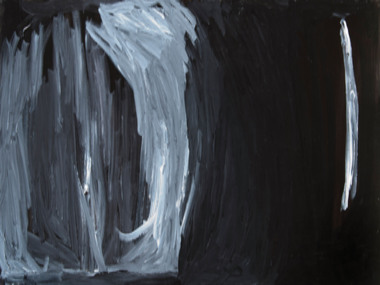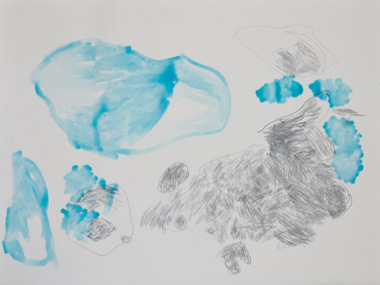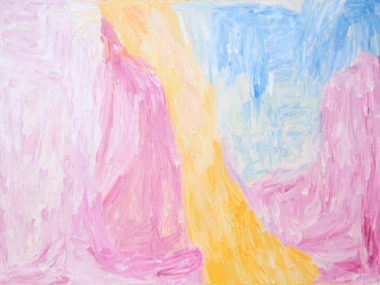SALLY GOES SOLO

Sally Gabori's dramatic 'Thundi' (2011) synthetic polymer paint on linen 101 x 196 cm. Collection: Dr Terry Cutler
Posted by Jeremy Eccles | 09.05.13
Gallery: Alcaston Gallery
Dates:
04.04.13
: 05.05.13
“Danda ngijinda dulk, danda ngijinda malaa, danda ngad - This is my Land, this is my Sea, this is who I am”.
That pretty much sums up the extraordinary mind behind the brilliant canvases that have flowed from brushes in the hands of Mirdidingkinggathi Juwarnda Sally Gabori since 2005. It also sums up the problem that encouraged her to paint in the first place!
For her language is Kayardild, and virtually no one apart from her late-80s self actually speaks it any longer. So her art is the only way she can share the history, geography ecology and stories of Bentinck Island, in the Gulf of Carpentaria, where she was born and grew up.
An aside – Kayardild, I learn from linguist Nicholas Evans' sad tome, 'Dying Words', is unique in that it actually breaks Noam Chomsky's absolute rule of Universal Grammar which says that “no language uses noun affixes to express tense” - for that would be too hard for children to pick up. A turtle seen in the past is a different word to a turtle predicted in the future. No wonder Gabori's children failed to learn it when the whole community of about 190 was transported from Bentinck to Mornington Island when a combination of drought and cyclone gave the missionaries an excuse to bring the Kayadilt people in from their wanton, unChristian existence.
Mind you, Gabori herself had known that wantonness – her husband Pat had killed her protecting brother in order to win her as his fourth wife!
Perhaps she was particularly desirable for her fishing, fish-trap building, story-telling and craftwork skills? For Bentinck was not a fertile island – it was just a heap of sand that reached 10 metres in height at its peak; but the seas around it were just swimming with food. And that fertility is at the core of Gabori's visual world – the movement of fish, the hunting of dugong, the patterning of crustaceans; mixed with the aerial views of Bentinck she experienced on visits by plane, and legends like Dibirdibi, the giant rock cod who cut the sea channels around Bentinck when the water levels rose after the last Ice Age, 9000 years ago.
Could that be a tale that's not unrelated to the Gija's Giant Barramundi in the East Kimberley, pursued by Lena Nyadbi's ancestors until it could only escape by leaping on to the land? There, its scales became Argyle Diamonds! And while Gabori has her first non-commercial solo show in Canberra (at the Drill Hall Gallery), Nyadbi is having her diamond scales blasted all over the roof of Paris's Quai Branly Museum. Over 70 metres square, they'll be clearly seen from the nearby Eiffel Tower.
Back in Canberra, the Drill Hall Gallery's new Director, Terence Maloon (ex-AGNSW) extols Gabori's art in the catalogue without really comprehending its role in her capacity to communicate: “How to explain the naked power of her use of colour, the commanding scale of her work, the sheer flair of this untutored painter – someone who had never actually seen paintings by Patrick Heron, Robert Motherwell, Jean Bazaine, but with whose spirit her art seem so close of kin? Her work has come to be associated with a joyous, extroverted timbre of sizzling scarlets, piercing yellows, opulent blues. As the American painter Barnett Newman once quipped: ‘Who’s afraid of red, yellow and blue?’ – Sally Gabori certainly is not”.
In June, Gabori gets taken even further away from her Bentinck Island fastness when her art appears in Venice in an international exhibition examining Time - Space and Existence. The exhibition, 'Personal Structure' is part of a project initiated in 2002 by the Dutch artist Rene Rietmeyer, “who noticed that even in the most distant corners of the world, there are artists working with Time - Space and Existence, thereby expressing themselves in a very personal way. This observation led to the idea of bringing several of these artists together in publications, exhibitions and symposia”. Let's hope that Gabori – alongside Michelangelo Pistoletto, Arnulf Rainer, Ben Vautier and fellow Aboriginal artist Yhonnie Scarce– can achieve the curators' dream of “stimulating a more conscious relation from the spectator towards his daily surrounding and aiming to increase the awareness of their own personal Existence as human beings within a specific Space and Time”!
This will run parallel to the main Venice Biennale.
Sadly, the Drill Hall show won't be travelling. The Gallery blames lack of funds for that, but it can't have helped that the exhibition's curator is also Gabori's major dealer – Beverley Knight from Melbourne – which might give rise to a conflict of interest in peoples' minds. Wouldn't it be tempting, for instance, to only select artworks that had passed through her Alcaston Gallery? That was a problem which institutional exhibitions of Emily Kngwarreye have encountered. Other galleries do deal in Sally's works - Raft, Art Mob and Wooloongabba spring to mind; and it was Simon Turner at the latter who first introduced Gabori to canvas and paint and showed her in Brisbane.
URL: dhg.anu.edu.au
Share this:
»  del.icio.us
»
del.icio.us
»  Digg it
»
Digg it
»  reddit
»
reddit
»  Google
»
Google
»  StumbleUpon
»
StumbleUpon
»  Technorati
»
Technorati
»  Facebook
Facebook
Contact Details
Gallery: Alcaston Gallery
Contact: Beverly Knight
Email: art@alcastongallery.com.au
Telephone: +61 3 9418 6444
Address: 11 Brunswick Street Fitzroy Melbourne 3065 VIC
Gallery: Drill Hall Gallery
Contact: Dr Terence Maloon
Email: dhg@anu.edu.au
Telephone: +61 2 6125 5832
Address: Kingsley Street Acton 2601 ACT

A recent experiment by Sally Gabori, 'Dibirdibi Country' (2012) watercolour and pencil on paper 55 x 75 cm. Courtesy of the artist

Another take on 'Thundi' by Sally Gabori, 'Big River Barramundi Story' (2008) synthetic polymer paint on linen 198 x 304 cm.The Arthur Roe Collection, Melbourne
Where is the exhibition?
Further Research
Gallery: Alcaston Gallery
Artists: Lena Nyadbi | Sally Gabori | Yhonnie Scarce
News Tags: Dying Words | Jeremy Eccles | Lena Nyadbi | Musee du Quai Branly | Personal Structure | Sally Gabori | Venice Biennale
News Categories: Australia | Blog | Europe | Exhibition | Feature | Industry | News
Exhibition Archive
- 10.10.17 | TARNANTHI 2017
- 11.08.17 | Natsiaas 2017
- 20.07.17 | APY ART DOMINATES THE WYNNE
- 17.07.17 | Anangu Artist Wins $100,000 Prize
- 14.07.17 | The End of AAMU
- 11.07.17 | ART ACROSS THE COUNTRY
- 11.07.17 | TARNANTHI IN OCTOBER
- 05.07.17 | TJUNGUṈUTJA - from having come together
- 13.06.17 | Ghost-Nets Straddle the World
- 07.06.17 | Grayson Perry Going Indigenous?
- 05.06.17 | Barks Bigger than Ben Hur
- 27.05.17 | NGA QUINQUENNIAL 2017
- 21.05.17 | Blak Douglas Finds Home at the NGA
- 21.05.17 | BRIAN ROBINSON WINS HAZELHURST WOP
- 18.05.17 | PARRTJIMA 2.0
Advertising

